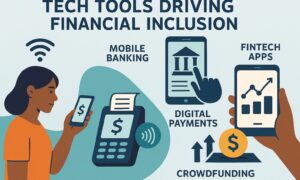In today’s modern world, financial inclusion has become a critical factor in driving economic growth and reducing poverty. However, many farmers in developing countries still face significant challenges when it comes to accessing financial services. This article aims to explore the concept of empowering farmers with financial inclusion, discussing its importance, benefits, and the various ways in which it can be achieved.
Understanding Financial Inclusion
Definition and Significance
Financial inclusion refers to the accessibility and usage of a range of financial services by individuals and businesses. It encompasses services such as savings, credit, insurance, and payment systems. In the context of farmers, financial inclusion implies providing them with the means to access these services, allowing them to make informed financial decisions and manage their agricultural activities more efficiently.
Challenges Faced by Farmers
Farmers in developing countries often face several challenges when it comes to financial inclusion. These challenges include limited access to formal banking institutions, lack of collateral, low financial literacy, and the absence of tailored financial products that meet their specific needs. As a result, farmers find it difficult to access credit, safeguard their savings, and protect themselves against risks such as crop failure or natural disasters.
The Importance of Financial Inclusion for Farmers
Economic Growth and Poverty Alleviation
Empowering farmers with financial inclusion can contribute significantly to economic growth and poverty alleviation. When farmers have access to credit, they can invest in modern agricultural techniques, purchase high-quality inputs, and expand their farming operations. This, in turn, leads to increased agricultural productivity, higher incomes, and improved standards of living for farmers and their families.
Increased Agricultural Productivity
Financial inclusion enables farmers to access affordable credit, which can be used to invest in farm machinery, irrigation systems, and other productivity-enhancing technologies. By leveraging these resources, farmers can enhance their productivity, optimize resource allocation, and adopt sustainable farming practices. This ultimately leads to higher crop yields and improved agricultural output.
Risk Management and Resilience
Farmers are exposed to various risks, including climate-related hazards, market fluctuations, and unpredictable income streams. With access to financial services, farmers can mitigate these risks by obtaining insurance coverage, creating emergency funds, and diversifying their income sources. Financial inclusion equips farmers with the tools to build resilience and recover from unforeseen setbacks.
Strategies for Empowering Farmers with Financial Inclusion
Digital Banking and Mobile Technology
The advent of digital banking and mobile technology has revolutionized the way financial services are delivered to farmers. Mobile banking apps and platforms allow farmers to open bank accounts, make transactions, and access credit and insurance services using their smartphones. This technology enables convenient, secure, and cost-effective financial inclusion, even in remote rural areas.
Microfinance Institutions
Microfinance institutions play a crucial role in providing financial services to farmers who have limited access to formal banking. These institutions offer small loans, savings accounts, and microinsurance products tailored to the needs of farmers. By focusing on financial inclusion at the grassroots level, microfinance institutions contribute to poverty reduction and sustainable development in rural communities.
Farmer Producer Organizations
Farmer Producer Organizations (FPOs) are collective entities formed by farmers to collectively market their produce, negotiate better prices, and access credit and other financial services. FPOs empower farmers by providing them with a collective voice, enhancing their bargaining power, and enabling them to pool resources for mutual benefit. These organizations promote financial inclusion by connecting farmers with formal financial institutions.
Government Initiatives and Policy Interventions
Governments play a crucial role in promoting financial inclusion among farmers through various initiatives and policy interventions. Some of these include:
Providing Access to Formal Banking
Governments can facilitate financial inclusion by encouraging banks to open branches and extend their services to rural areas. This ensures that farmers have convenient access to banking facilities, including savings accounts, credit, and insurance services.
Financial Literacy and Education Programs
Promoting financial literacy and education programs equips farmers with the knowledge and skills necessary to make informed financial decisions. By improving financial literacy, farmers become more capable of managing their finances, understanding the benefits of formal banking, and avoiding exploitation by unscrupulous lenders.
Subsidies and Credit Guarantee Schemes
Governments can implement subsidies and credit guarantee schemes to incentivize banks and other financial institutions to provide loans and financial services to farmers. These schemes reduce the risks associated with lending to farmers and ensure that credit is accessible and affordable.
Case Studies: Successful Models of Financial Inclusion
Grameen Bank – Bangladesh
Grameen Bank, founded by Nobel Laureate Muhammad Yunus, pioneered the concept of microcredit and played a significant role in empowering farmers and rural communities in Bangladesh. The bank provides small loans to farmers, particularly women, without requiring collateral. This approach has been highly successful in improving financial inclusion, reducing poverty, and fostering entrepreneurship among farmers.
Kisan Credit Card – India
The Kisan Credit Card (KCC) scheme in India is a government initiative aimed at providing farmers with timely and adequate credit for their agricultural activities. Under this scheme, farmers are issued a credit card that allows them to access short-term credit, purchase inputs, and meet their working capital requirements. The KCC scheme has greatly enhanced financial inclusion and improved access to credit for farmers across India.
- Check Pm Kisan Status: Tracking the progress of the Kisan Credit Card scheme in India.
- PM Kisan Status KYC: Ensuring transparency and verifying farmers’ information for effective implementation of the Kisan Credit Card scheme.
- Pm Kisan Status Check 2021: Easily verify your name on the beneficiary list for the Kisan Credit Card scheme.
M-Pesa – Kenya
M-Pesa, a mobile-based money transfer and microfinancing service, has transformed financial inclusion in Kenya. Through M-Pesa, farmers can conduct secure and convenient financial transactions, access credit, and save money using their mobile phones. This technology has revolutionized the way farmers manage their finances, ensuring that they have a safe and accessible platform to conduct their financial activities.
The Role of Technology in Financial Inclusion
Mobile Banking Apps
Mobile banking apps have made financial services more accessible to farmers, eliminating the need for physical visits to banks or financial institutions. These apps allow farmers to check their account balances, transfer funds, and make payments conveniently from their smartphones. The convenience and ease of use offered by mobile banking apps have significantly contributed to financial inclusion for farmers.
Blockchain and Cryptocurrencies
Blockchain technology and cryptocurrencies have the potential to revolutionize financial inclusion by providing secure and transparent financial services. Blockchain-based platforms can facilitate digital transactions, enable smart contracts, and ensure the traceability of funds. Cryptocurrencies can serve as an alternative form of digital currency, offering farmers a decentralized and accessible means of storing and transferring value.
Challenges and Future Directions
While significant progress has been made in empowering farmers with financial inclusion, several challenges remain. These challenges include:
Infrastructure and Connectivity
Limited infrastructure and connectivity in rural areas pose obstacles to financial inclusion. Farmers need reliable access to internet connectivity and mobile networks to leverage digital financial services fully. Governments and private organizations must invest in expanding infrastructure to bridge the digital divide and ensure widespread financial inclusion.
Gender Disparities
Gender disparities persist in financial inclusion, with women farmers facing greater challenges in accessing financial services. Cultural and societal barriers, limited land ownership rights, and lower levels of financial literacy contribute to these disparities. Efforts must be made to promote gender equality in financial inclusion initiatives and provide tailored services that address the specific needs of women farmers.
Sustainable Financing Models
Sustainable financing models are crucial to ensuring the long-term success of financial inclusion initiatives. Financial services must be designed in a way that is economically viable and sustainable for both farmers and financial institutions. Innovations such as revenue-sharing models, impact investing, and public-private partnerships can contribute to the development of sustainable financing models for farmers.
Conclusion
Financial inclusion has the power to transform the lives of farmers by providing them with the necessary tools and resources to thrive in their agricultural endeavors. By empowering farmers with access to financial services, we can enhance agricultural productivity, alleviate poverty, and foster sustainable development in rural communities. Governments, financial institutions, and technology providers must collaborate to overcome the challenges and work towards a future where all farmers can benefit from financial inclusion.



































